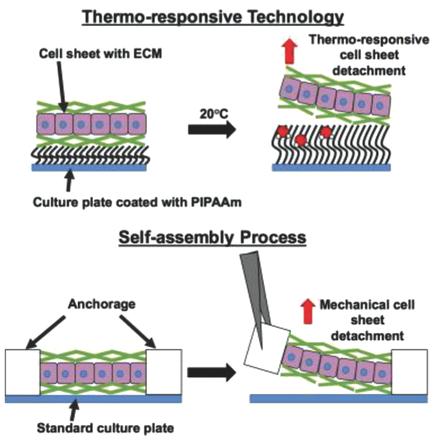当前位置:
X-MOL 学术
›
Adv. Healthcare Mater.
›
论文详情
Our official English website, www.x-mol.net, welcomes your
feedback! (Note: you will need to create a separate account there.)
Biomimetic Tissue‐Engineered Bone Substitutes for Maxillofacial and Craniofacial Repair: The Potential of Cell Sheet Technologies
Advanced Healthcare Materials ( IF 10.0 ) Pub Date : 2017-12-27 , DOI: 10.1002/adhm.201700919 Fabien Kawecki 1, 2 , William P. Clafshenkel 1, 2 , Michel Fortin 1, 3 , François A. Auger 1, 2 , Julie Fradette 1, 2
Advanced Healthcare Materials ( IF 10.0 ) Pub Date : 2017-12-27 , DOI: 10.1002/adhm.201700919 Fabien Kawecki 1, 2 , William P. Clafshenkel 1, 2 , Michel Fortin 1, 3 , François A. Auger 1, 2 , Julie Fradette 1, 2
Affiliation

|
Maxillofacial defects are complex lesions stemming from various etiologies: accidental, congenital, pathological, or surgical. A bone graft may be required when the normal regenerative capacity of the bone is exceeded or insufficient. Surgeons have many options available for bone grafting including the “gold standard” autologous bone graft. However, this approach is not without drawbacks such as the morbidity associated with harvesting bone from a donor site, pain, infection, or a poor quantity and quality of bone in some patient populations. This review discusses the various bone graft substitutes used for maxillofacial and craniofacial repair: allografts, xenografts, synthetic biomaterials, and tissue‐engineered substitutes. A brief overview of bone tissue engineering evolution including the use of mesenchymal stem cells is exposed, highlighting the first clinical applications of adipose‐derived stem/stromal cells in craniofacial reconstruction. The importance of prevascularization strategies for bone tissue engineering is also discussed, with an emphasis on recent work describing substitutes produced using cell sheet‐based technologies, including the use of thermo‐responsive plates and the self‐assembly approach of tissue engineering. Indeed, considering their entirely cell‐based design, these natural bone‐like substitutes have the potential to closely mimic the osteogenicity, osteoconductivity, osteoinduction, and osseointegration properties of autogenous bone for maxillofacial and craniofacial reconstruction.
中文翻译:

仿生组织工程骨替代物用于颌面和颅面修复:细胞表技术的潜力
颌面部缺损是由多种病因引起的复杂病变:意外,先天性,病理性或手术性。当骨骼的正常再生能力被超过或不足时,可能需要植骨。外科医生有许多可用于骨移植的选择,包括“金标准”自体骨移植。但是,这种方法并非没有缺点,例如与从供体部位采集骨头相关的发病率,疼痛,感染或某些患者人群中骨头的数量和质量较差。这篇综述讨论了用于颌面和颅面修复的各种骨移植替代物:同种异体移植物,异种移植物,合成生物材料以及组织工程替代物。简要概述了骨组织工程的发展,包括间充质干细胞的使用,强调了脂肪干/基质细胞在颅面重建中的首次临床应用。还讨论了血管形成前策略在骨组织工程中的重要性,重点是描述使用基于细胞片的技术生产的替代物的最新工作,包括使用热响应板和组织工程的自组装方法。的确,考虑到其完全基于细胞的设计,这些天然骨样替代物具有密切模仿自体骨用于颌面和颅面重建的成骨性,骨传导性,骨诱导性和骨整合特性的潜力。还讨论了血管形成前策略在骨组织工程中的重要性,重点是描述使用基于细胞片的技术生产的替代物的最新工作,包括使用热响应板和组织工程的自组装方法。的确,考虑到其完全基于细胞的设计,这些天然骨样替代物具有密切模仿自体骨用于颌面和颅面重建的成骨性,骨传导性,骨诱导性和骨整合特性的潜力。还讨论了血管形成前策略在骨组织工程中的重要性,重点是描述使用基于细胞片的技术生产的替代物的最新工作,包括使用热响应板和组织工程的自组装方法。的确,考虑到其完全基于细胞的设计,这些天然骨样替代物具有密切模仿自体骨用于颌面和颅面重建的成骨性,骨传导性,骨诱导性和骨整合特性的潜力。
更新日期:2017-12-27
中文翻译:

仿生组织工程骨替代物用于颌面和颅面修复:细胞表技术的潜力
颌面部缺损是由多种病因引起的复杂病变:意外,先天性,病理性或手术性。当骨骼的正常再生能力被超过或不足时,可能需要植骨。外科医生有许多可用于骨移植的选择,包括“金标准”自体骨移植。但是,这种方法并非没有缺点,例如与从供体部位采集骨头相关的发病率,疼痛,感染或某些患者人群中骨头的数量和质量较差。这篇综述讨论了用于颌面和颅面修复的各种骨移植替代物:同种异体移植物,异种移植物,合成生物材料以及组织工程替代物。简要概述了骨组织工程的发展,包括间充质干细胞的使用,强调了脂肪干/基质细胞在颅面重建中的首次临床应用。还讨论了血管形成前策略在骨组织工程中的重要性,重点是描述使用基于细胞片的技术生产的替代物的最新工作,包括使用热响应板和组织工程的自组装方法。的确,考虑到其完全基于细胞的设计,这些天然骨样替代物具有密切模仿自体骨用于颌面和颅面重建的成骨性,骨传导性,骨诱导性和骨整合特性的潜力。还讨论了血管形成前策略在骨组织工程中的重要性,重点是描述使用基于细胞片的技术生产的替代物的最新工作,包括使用热响应板和组织工程的自组装方法。的确,考虑到其完全基于细胞的设计,这些天然骨样替代物具有密切模仿自体骨用于颌面和颅面重建的成骨性,骨传导性,骨诱导性和骨整合特性的潜力。还讨论了血管形成前策略在骨组织工程中的重要性,重点是描述使用基于细胞片的技术生产的替代物的最新工作,包括使用热响应板和组织工程的自组装方法。的确,考虑到其完全基于细胞的设计,这些天然骨样替代物具有密切模仿自体骨用于颌面和颅面重建的成骨性,骨传导性,骨诱导性和骨整合特性的潜力。











































 京公网安备 11010802027423号
京公网安备 11010802027423号